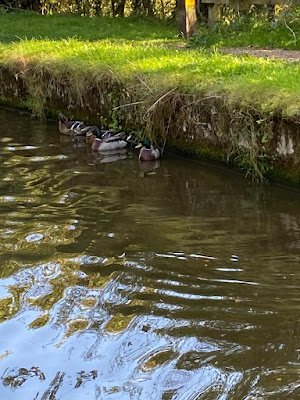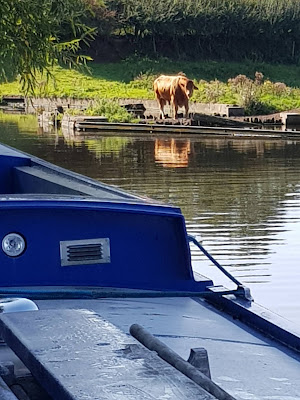Friday 11th
September 2020
Very conscious of the
27 locks ahead of us, we set off fairly early, about 8:15. Another
consideration in my mind was a concern about availability of mooring in the
centre of Birmingham – I didn’t want to arrive late and find that all the good
spaces were taken, and have to moor somewhere insalubrious.
Within half a mile we
started to travel through more built up areas, and soon came to the first of
the Minworth locks. There are three of these, well spaced out, and really just
a small worm-up for the rest of the day. Beyond the Minworth locks we were
definitely passing through industrial areas, with factories in various states
of dilapidation, pipe bridges and general grime. We came to a spot where a
factory is actually built right over the canal, so that for several hundred
yards you are running through a semi-tunnel made out of concrete pillars –
there is open air out through the pillars on one side, but otherwise you are
effectively underground.
 |
Factory over the canal
|
Immediately after
this we came to an electricity substation towering over us, with the biggest
insulators and terminals I have ever seen. Now we were running alongside (and
below) the M6, at Spaghetti Junction. Looking through the pillars below the
motorway we could see Star City, an entertainment complex I have seen many
times when driving past.
 |
Spaghetti Junction
|
It may be Spaghetti
Junction for motorists, but for a couple of hundred years before that this has
been Salford Junction, the meeting of three canals. The Birmingham and Fazeley,
which we were following, continues on towards the centre of the city. On our
left, going south east, the Grand Union Canal starts from here. And to the
right, going north west, is the Tame Valley branch of the Birmingham Canal
Network (BCN). This looked narrow and little-travelled – many of the side
branches of the BCN do not have many visitors, and are apparently often rather
weed-choked and tricky to navigate. At some future time we will come down here
and see if we can explore all the odd little back arms and loops, but for today
we had a very specific objective, and we stuck to the main line.
 |
Salford Junction below the M6
|
Loulie took the helm
for a little while after the junction, and soon after, just past Cuckoo Bridge,
she had a nasty shouting match with an unpleasant pair in a moored boat and
dinghy, who seemed to feel that even tickover was too fast as we went past
them.
We had now reached
the bottom of the Aston flight, and started up. After the first three these
locks are all very close together, and Loulie got out and worked them all,
walking between them. She started to find that some of the locks we came to had
their upper gates left open, which is a nuisance as she has to close them
before starting to work the lock. It turned out that the boat ahead of us was
another vlogger, called Robbie Cummings. He had two people helping him – one
was going ahead working the locks, and the other was supposed to be following
up. Sadly this bloke was also running a drone with which he was filming their
progress, and he clearly could not spare the time from those duties to bother
following canal etiquette. Loulie spoke to him, but it did not seem to have
much effect. Fortunately we passed a number of boats coming the other way, and
when that happened the locks were set in our favour.
 |
On the Aston flight
|
Also more positive
was a boat which was following us, one lock back. It seemed that this was a
boat which had just been bought by a couple, and an experienced boater was
helping them move it. He was working them into each lock and then leaving them
to complete it while he came forward to help speed us on our way, by closing
the gate behind me and allowing me simply to sail off. Without that help I was
having to pull in and get off to close the gate, while Loulie went ahead to the
next lock. Stuff like this makes a big difference when you are working up a
long flight.
At the top of the
Aston flight we came straight out at a T junction. To our left the Digbeth
branch leads down six locks and two short tunnels to the Typhoo basin, and
eventually links up with the Grand Union, coming down from Salford Junction.
Again, next time we are here we will explore that alternative route. But today
we were turning right, and along a pound of about half a mile to the bottom of
the Farmers Bridge flight – thirteen locks which would take us to the end of
our journey today. As we approached the bottom lock we saw Robbie Cummings
moored on the towpath, so at least we would not be following him this time.
The Farmers Bridge
locks are all close together, with very short pounds between them. Lock 12 (the
second one we came to) is right below Snow Hill station, with huge concrete
pillars and pools of water off to the side. Lock 9 is right underneath a
towering office building. The whole flight feels as though it is in a deep
canyon, with tall buildings rising on either side, and more coming into view straight
ahead. We continued to have help from the boat behind us, and part way up the
flight a couple of vlokkies appeared, which helped us on our way considerably.
In the end we reached the top of the flight before three.
Loulie had asked one
of the vlokkies about the best place to moor, and he had given her some advice.
When we came out of the top lock we went ahead a few hundred yards then came
out at a “roundabout” – Old Turn Junction. This whole area was completely
unlike anything we had expected. Far from the seedy and run-down parts of
Manchester which the Rochdale Canal passes through, this was the high-rent part
of Birmingham. The canals are very wide, and the banks newly made, with stone
sides and wide towpaths/footpaths, busy with shoppers, joggers and local
residents. Large buildings overlook it – the Birmingham Arena, the Sea Life
Centre and several new apartment blocks. The towpaths are lined with wine bars,
restaurants and pubs – we could have moored outside Zizzi’s and had dinner
there, if we had wanted to.
The roundabout where
we had emerged was a small circular island in the centre of a wide area of water,
with three canals heading off it, in addition to the B&F which had brought
us out here. To our left was a stretch leading to Gas Street Basin, and beyond
to the Worcester & Birmingham Canal. Straight ahead was the Old Turn itself
– a short loop going ahead and then round to the right. And on the right was
the beginning of the New Main Line of the BCN, which runs straight out of the
city to the west. This was where we chose to moor, on the left hand side (there
are towpaths on both banks), in front of some apartments and opposite the
Arena. The neat stone banks were lined with rings, so we had no problem
mooring, and there was plenty of space. It filled up a little later, but there
was still loads of room in the various arms – my concerns earlier were entirely
unfounded.
 |
Bridge at Mail Box Turn
|
 |
Birmingham & Worcs Canal going south
|
 |
Local architecture
|
 |
Gas Street Basin
|
 |
Looking west towards Old Loop Turn
|
 |
| High end shopping |
We took the dogs for
a walk, and discovered one of the few downsides of this mooring – an almost complete
absence of grass for the girls to tiddle on. Close to the boat the towpath was
stone and tarmac, and further down there were just a few tiny scraps of grass
behind an occasional tree. We walked over the junction and down past some
flats, and eventually found enough green patches to allow them to relieve
themselves.
After that I went on
a longer walk, to get a few provisions and to scout for takeaways. I walked
down past Gas Street Basin to Mail Box corner, where the canal turns ninety
degrees right and heads off to the south. The “Mail Box” is a shopping mall –
very high class, places like Gieves and Hawkes, Harvey Nicks and Emporio
Armani. It also contains the offices of BBC Birmingham. I walked through there
and down towards the Town Hall (a massive Victorian pile) and New Street
Station, which is clad in an amazing sheath of curving reflective silver, more
like a space ship than a railway station. Off in the distance I could see the
Bullring and Selfridges, another bizarre curved silver building, this time
covered in large hemispherical shapes.
Our plan was to have
a Chinese takeaway, and Google Maps showed us Chinatown a mile or so away. We
picked a restaurant and ordered on line, and I set off walking. I found it OK,
but it was shuttered and under renovation – at that point I got a text message
cancelling our online order. I was able to find another place close by and
ordered, but on a busy Friday night I had to wait around for about 40 minutes
before it was cooked. By the time I got back to the boat we were very ready to
eat.
At bedtime we had the
grass problem again – Bridget takes long enough at the best of times to do her
last tiddle, and tonight I had to walk her up and down the towpath, over
bridges and down side roads before she finally found a green spot that she
liked.
TODAY: 6:45 HOURS. 8.0 MILES. 27 LOCKS.
Voyage: 50:40 HOURS. 87.2 MILES. 76
LOCKS.





















































